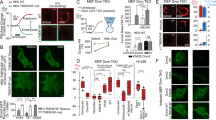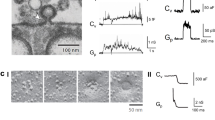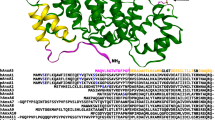Abstract
Disruption of the cell plasma membrane is a commonplace occurrence in many mechanically challenging, biological environments. 'Resealing' is the emergency response required for cell survival. Resealing is triggered by Ca2+ entering through the disruption; this causes vesicles present in cytoplasm underlying the disruption site to fuse rapidly with one another (homotypically) and also with the adjacent plasma membrane (heterotypically/exocytotically). The large vesicular products of homotypic fusion are added as a reparative 'patch' across the disruption, when its resealing requires membrane replacement. The simultaneous activation of the local cytoskeleton supports these membrane fusion events. Resealing is clearly a complex and dynamic cell adaptation, and, as we emphasize here, may be an evolutionarily primitive one that arose shortly after the ancestral eukaryote lost its protective cell wall.
This is a preview of subscription content, access via your institution
Access options
Subscribe to this journal
Receive 12 print issues and online access
$209.00 per year
only $17.42 per issue
Buy this article
- Purchase on Springer Link
- Instant access to full article PDF
Prices may be subject to local taxes which are calculated during checkout




Similar content being viewed by others
References
Fuchs, E. & Cleveland, D. W. A structural scaffolding of intermediate filaments in health and disease. Science 279, 514–519 (1998).
Galou, M. et al. The importance of intermediate filaments in the adaptation of tissues to mechanical stress: evidence from gene knockout studies. Biol. Cell 89, 85–97 (1997).
McNeil, P. L. & Steinhardt, R. A. Loss, restoration and maintenance of plasma membrane integrity. J. Cell Biol. 137, 1–4 (1997).
Clarke, M. S., Caldwell, R. W., Chiao, H., Miyake, K. & McNeil, P. L. Contraction-induced cell wounding and release of fibroblast growth factor in heart. Circ. Res. 76, 927–934 (1995).
McNeil, P. L. & Khakee, R. Disruptions of muscle fiber plasma membranes. Role in exercise-induced damage. Am. J. Pathol. 140, 1097–1109 (1992).
Clarke, M. F. C., Khakee, R. & McNeil, P. L. Loss of cytoplasmic basic fibroblast growth factor from physiologically wounded myofibers of normal and dystrophic muscle. J. Cell Sci. 106, 121–133 (1993).
Petrof, B. J., Shrager, J. B., Stedman, H. H., Kelly, A. M. & Sweeney, H. L. Dystrophin protects the sarcolemma from stresses developed during muscle contraction. Proc. Natl Acad. Sci. USA 90, 3710–3714 (1993).
Lemasters, J. L., DiGuiseppi, J., Nieminen, A.-L. & Herman, B. Blebbing, free Ca2+ and mitochondrial membrane potential preceding cell death in hepatocytes. Nature 325, 78–81 (1987).
Swanson, J. A. & Taylor, D. L. Local and spatially coordinated movements in Dictyostelium discoideum amoebae during chemotaxis. Cell 28, 225–232 (1982).
Olfers-Weber, R., Stockem, W. & Wohlfarth-Bottermann, K. E. in Ion and Enzyme Electrodes in Biology and Medicine (eds Kessler, M. et al.) 205–216 (University Park Press, Baltimore, 1976).
Casademont, J., Carpenter, S. & Karpati, G. Vacuolation of muscle fibers near sarcolemmal breaks represents T-tubule dilatation secondary to enhanced sodium pump activity. J. Neuropathol. Exp. Neurol. 47, 618–628 (1988).
Swanson, J. A. & McNeil, P. L. Nuclear reassembly excludes large macromolecules. Science 238, 548–550 (1987).
Terasaki, M., Miyake, K. & McNeil, P. L. Large plasma membrane disruptions are rapidly resealed by Ca2+-dependent vesicle–vesicle fusion events. J. Cell Biol. 139, 63–74 (1997).
Lieber, M. R. & Steck, T. L. A description of the holes in human erythrocyte membrane ghosts. J. Biol. Chem. 257, 11651–11659 (1982).
Lieber, M. R. & Steck, T. L. Dynamics of the holes in human erythrocyte membrane ghosts. J. Biol. Chem. 257, 11660–11666 (1982).
Parsegian, V. A., Rand, R. P. & Gingell, D. Lessons for the study of membrane fusion from membrane interactions in phospholipid systems. Ciba Found. Symp. 103, 9–27 (1984).
Chernomordik, L. V., Melikyan, G. B. & Chizmadzhev, Y. A. Biomembrane fusion: a new concept derived from model studies using two interacting planar lipid bilayers. Biochim. Biophys. Acta 906, 309–352 (1987).
Steinhardt, R. A., Bi, G. & Alderton, J. M. Cell membrane resealing by a vesicular mechanism similar to neurotransmitter release. Science 263, 390–393 (1994).
Xie, X. Y. & Barrett, J. N. Membrane resealing in cultured rat septal neurons after neurite transection: evidence for enhancement by Ca2+-triggered protease activity and cytoskeletal disassembly. J. Neurosci. 11, 3257–3267 (1991).
Miyake, K. & McNeil, P. L. Vesicle accumulation and exocytosis at sites of plasma membrane disruption. J. Cell Biol. 131, 1737–1745 (1995).
Togo, T., Alderton, J. M., Bi, G. Q. & Steinhardt, R. A. The mechanism of facilitated cell membrane resealing. J. Cell Sci. 112, 719–731 (1999).
Bi, G.-Q., Alderton, J. M. & Steinhardt, R. A. Calcium-regulated exocytosis is required for cell membrane resealing. J. Cell Biol. 131, 1747–1758 (1995).
Coorsen, J. H., Schmitt, H. & Almers, W. Ca2+ triggers massive exocytosis in Chinese hamster ovary cells. EMBO J. 15, 3787–3791 (1996).
Penner, R. & Neher, E. The role of calcium in stimulus–secretion coupling in excitable and non-excitable cells. J. Exp. Biol. 139, 329–345 (1988).
Rodriguez, A., Webster, P., Ortego, J. & Andrews, N. W. Lysosomes behave as Ca2+-regulated exocytotic vesicles in fibroblasts and epithelial cells. J. Cell Biol. 137, 93–104 (1997).
McNeil, P. L., Vogel, S. S., Miyake, K. & Terasaki, M. Patching plasma membrane disruptions with cytoplasmic membrane. J. Cell Sci. 113, 1891–1902 (2000).
Wallace, R. A., Opresko, L., Wiley, H. S. & Selman, K. The oocyte as an endocytic cell. Ciba Found. Symp. 98, 228–248 (1983).
Dai, J. & Sheetz, M. P. Membrane tether formation from blebbing cells. Biophys. J. 77, 3363–3370 (1999).
Raucher, D. & Sheetz, M. P. Characteristics of a membrane reservoir buffering membrane tension. Biophys. J. 77, 1992–2002 (1999).
Needham, D. & Hochmuth, R. M. Electro-mechanical permeabilization of lipid vesicles. Role of membrane tension and compressibility. Biophys. J. 55, 1001–1009 (1989).
Raucher, D. & Sheetz, M. P. Cell spreading and lamellipodial extension rate is regulated by membrane tension. J. Cell Biol. 148, 127–136 (2000).
Togo, T., Krasieva, T. B. & Steinhardt, R. A. A decrease in membrane tension precedes successful cell-membrane repair. Mol. Biol. Cell 11, 4339–4346 (2000).
Clarke, M. S. F. & McNeil, P. L. Syringe loading introduces macromolecules into living mammalian cell cytosol. J. Cell Sci. 102, 535–541 (1992).
Bakker, A. C., Webster, P., Jacob, W. A. & Andrews, N. W. Homotypic fusion between aggregated lysosomes triggered by elevated [Ca2+]i in fibroblasts. J. Cell Sci. 110, 2227–2238 (1997).
McNeil, P. L. & Baker, M. Cell surface events during resealing visualized by scanning electron microscopy. Cell Tiss. Res. (in the press).
Rothman, J. E. The protein machinery of vesicle budding and fusion. Protein Sci. 5, 185–194 (1996).
Nichols, B. J., Ungermann, C., Pelham, H. R., Wickner, W. T. & Haas, A. Homotypic vacuolar fusion mediated by t- and v-SNAREs. Nature 387, 199–202 (1997).
Mayorga, L. S. et al. Calcium-dependent fusion among endosomes. J. Biol. Chem. 269, 30927–30934 (1994).
Eddleman, C. S., Bittner, G. D. & Fishman, H. M. Barrier permeability at cut axonal ends progressively decreases until an ionic seal is formed. Biophys. J. (in the press).
Eddleman, C. S., Ballinger, M. L., Smyers, M. E., Fishman, H. M. & Bittner, G. D. Endocytotic formation of vesicles and other membranous structures induced by Ca2+ and axolemmal injury. J. Neurosci. 18, 4029–4041 (1998).
Eddleman, C. S. et al. Repair of plasmalemmal lesions by vesicles. Proc. Natl Acad. Sci. USA 94, 4745–4750 (1997).
Godell, C. M. et al. Calpain activity promotes the sealing of severed giant axons. Proc. Natl Acad. Sci. USA 94, 4751–4756 (1997).
Howard, M. J., David, G. & Barrett, J. N. Resealing of transected myelinated mammalian axons in vivo: evidence for involvement of calpain. Neuroscience 93, 807–815 (1999).
Gitler, D. & Spira, M. E. Real time imaging of calcium-induced localized proteolytic activity after axotomy and its relation to growth cone formation. Neuron 20, 1123–1135 (1998).
Spira, M. E., Benbassat, D. & Dormann, A. Resealing of the proximal and distal cut ends of transected axons: electrophysiological and ultrastructural analysis. J. Neurobiol. 24, 300–316 (1993).
Ziv, N. E. & Spira, M. E. Localized and transient elevations of intracellular Ca2+ induce the dedifferentiation of axonal segments into growth cones. J. Neurosci. 17, 3568–3579 (1997).
Jedd, G. & Chua, N. H. A new self-assembled peroxisomal vesicle required for efficient resealing of the plasma membrane. Nature Cell Biol. 2, 226–231 (2000).
Bi, G. Q. et al. Kinesin- and myosin-driven steps of vesicle recruitment for Ca2+-regulated exocytosis. J. Cell Biol. 138, 999–1008 (1997).
Taylor, D. L. & Fechheimer, M. Cytoplasmic structure and contractility: the solation–contraction coupling hypothesis. Phil. Trans. R. Soc. Lond. B 299, 185–197 (1982).
Bement, W. M., Mandato, C. A. & Kirsch, M. N. Wound-induced assembly and closure of an actomyosin purse string in Xenopus oocytes. Curr. Biol. 9, 579–587 (1999).
Ziv, N. E. & Spira, M. E. Induction of growth cone formation by transient and localized increases of intracellular proteolytic activity. J. Cell Biol. 140, 223–232 (1998).
Detrait, E. et al. Axolemmal repair requires proteins that mediate synaptic vesicle fusion. J. Neurobiol. (in the press).
Martinez, I. et al. Synaptotagmin VII regulates Ca2+-dependent exocytosis of lysosomes in fibroblasts. J. Cell Biol. 148, 1141–1149 (2000).
Miki, N. et al. Role of annexin in membrane resealing. Mol. Biol. Cell 11, 384 (2000).
Chen, W. T. Mechanism of retraction of the trailing edge during fibroblast movement. J. Cell Biol. 90, 187–200 (1981).
Kreitzer, A. C., Gee, K. R., Archer, E. A. & Regehr, W. G. Monitoring presynaptic calcium dynamics in projection fibers by in vivo loading of a novel calcium indicator. Neuron 27, 25–32 (2000).
Weiner, D. B. & Kennedy, R. C. Genetic vaccines. Scient. Am. 281, 50–57 (1999).
Wolff, J. A. et al. Direct gene transfer into mouse muscle in vivo. Science 247, 1465–1468 (1990).
Delaney, K., Davison, I. & Denk, W. Odour-evoked [Ca2+] transients in mitral cell dendrites of frog olfactory glomeruli. Eur. J. Neurosci. (in the press).
McNeil, P. L., Murphy, R. F., Lanni, F. & Taylor, D. L. A method for incorporating macromolecules into adherent cells. J. Cell Biol. 98, 1556–1564 (1984).
Grembowicz, K. P., Sprague, D. & McNeil, P. L. Temporary disruption of the plasma membrane is required for c-fos expression in response to mechanical stress. Mol. Biol. Cell 10, 1247–1257 (1999).
McNeil, P. L., Muthukrishnan, L., Warder, E. & D'Amore, P. A. Growth factors are released by mechanically wounded endothelial cells. J. Cell Biol. 109, 811–822 (1989).
Ku, P. & D'Amore, P. A. Regulation of basic fibroblast growth factor (bFGF) gene and protein expression following its release from sublethally injured endothelial cells. J. Cell. Biochem. 58, 328–343 (1995).
Zhelev, D. V. & Needham, D. Tension-stabilized pores in giant vesicles: determination of pore size and pore line tension. Biochim. Biophys. Acta 1147, 89–104 (1993).
Author information
Authors and Affiliations
Corresponding authors
Rights and permissions
About this article
Cite this article
McNeil, P., Terasaki, M. Coping with the inevitable: how cells repair a torn surface membrane. Nat Cell Biol 3, E124–E129 (2001). https://doi.org/10.1038/35074652
Issue Date:
DOI: https://doi.org/10.1038/35074652
This article is cited by
-
Pyroptosis and pyroptosis-inducing cancer drugs
Acta Pharmacologica Sinica (2022)
-
Microengineered filters for efficient delivery of nanomaterials into mammalian cells
Scientific Reports (2022)
-
Assembly of Tetraspanin-enriched macrodomains contains membrane damage to facilitate repair
Nature Cell Biology (2022)
-
Particle-based simulations of bilayer membranes: self-assembly, structural analysis, and shock-wave damage
Computational Particle Mechanics (2017)



